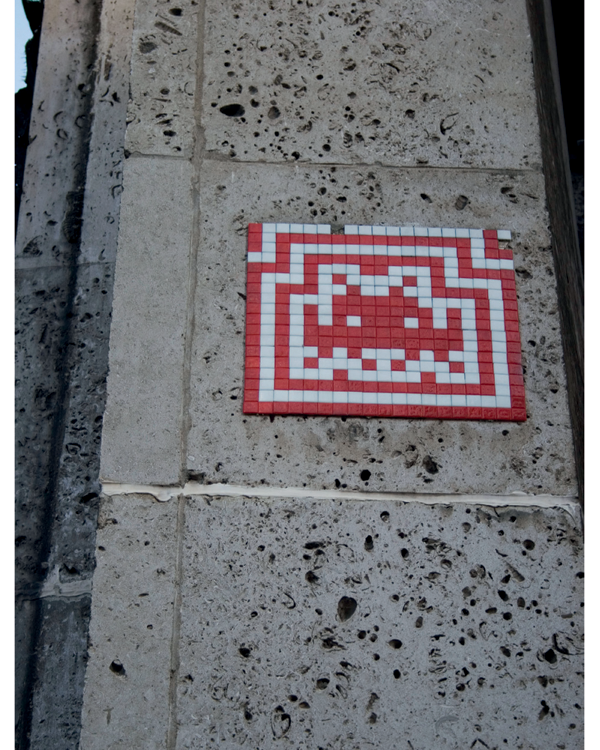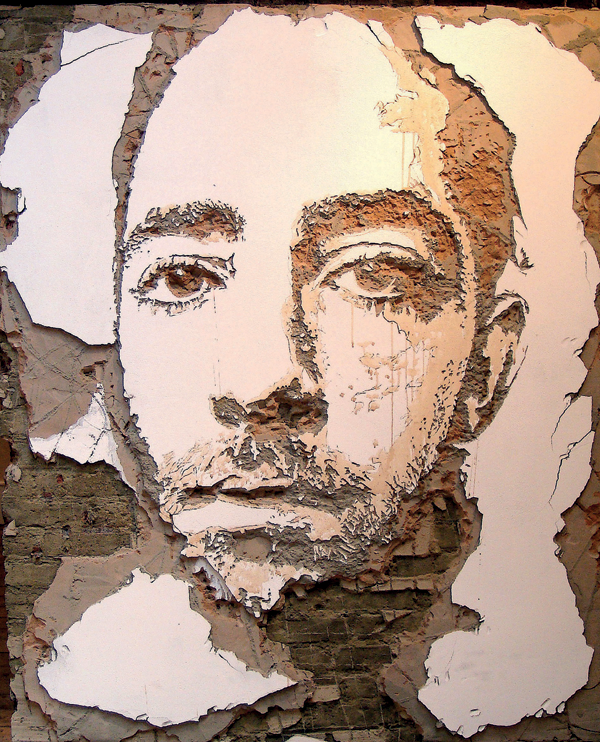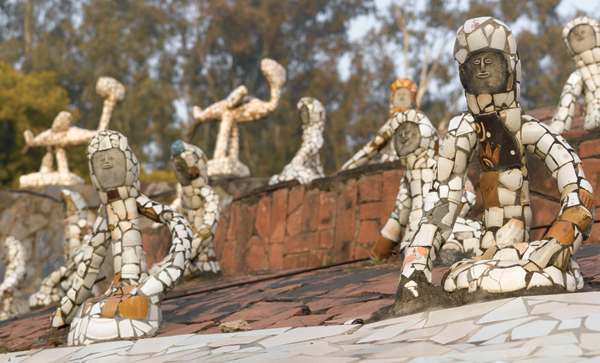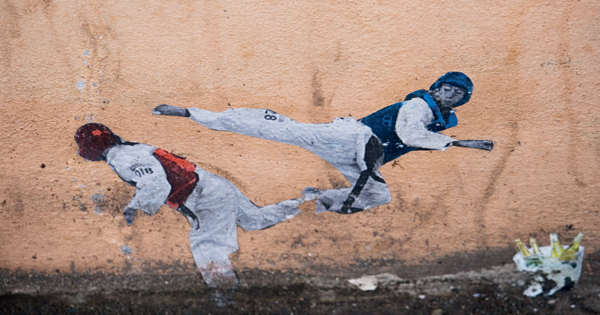INVADER
from Paris, France
The inclusion of a self-referential paint roller or spray can in Invader’s more recent work is a sharp observation on most other street artists’ methods, as this French artist uses ceramic tiles to construct his nostalgic gaming icons, not paint.
Hugely pixelated aliens were the screen anti-heroes of arcade video games such as Space Invaders that originated in Japan in the late 1970s. The use of ceramic tiles to recreate enlarged versions of these icons provides a commentary on our surveillance society and the occupation of public spaces. The extreme pixelation references methods used by the media to disguise car registration plates and faces in order to protect the rights of individuals in factual television programmes.
This artist first ‘invaded’ Paris in 1998, spreading to over 30 other French cities before crossing international borders into Australia, Austria, Canada, India, Italy, Germany, Japan, Kenya, Nepal, the Netherlands, Spain, Switzerland, the UK and the USA.
As these gaming images were created using very low-resolution graphics, they are perfectly suited for transmutation into small mosaics. Most often placed high up on buildings, they are difficult to damage or paint over, and have proved to be among the most resilient forms of street art around.







VHILS
From South Bank near Lisbon, Portugal
This rising international star and his crew create highly original work using his signature method of careful destruction and delicate rebuilding of relief sculpture that protrudes from chiselled-back walls. His pseudonym Vhils has no real meaning, but simply derives from the fastest set of letters he could apply in a hurry while working illegally.
As a teenager, he experimented with bleach and acids as agents of destruction on train exteriors and poster sites, before moving on to work with pneumatic drills to excavate sections of wall. As an archaeologist of the temporary structure, his process exposes the strata of urban layering and fills it with portraits that raise issues, pose questions and challenge perceptions.
While tearing apart the socio-historical fabric of the built environment, his methods have become less refined, as the rough process of removal and disruptive innovation is metamorphosed into staggered beauty.
This young artist has also directed a music video featuring his original 3D murals.






TOOTHFISH
from Great Barrier Island, South Pacific
Toothfish began with a poster project to raise awareness of global environmental concerns that has appeared in Australia, Brazil, India, New Zealand, Ukraine, the UK and the USA. The slogan ‘The War Against Nature is Over!’ was particularly pertinent when posted in Japan just before the devastating tsunami in 2011. Toothfish has become a creative ambassador whose works represent the threat to the natural world from human activity.
The toothfish itself is native to the seas around Antarctica and is a species so under threat that Greenpeace are staging a campaign to highlight its plight. As it is only a matter of time before it becomes extinct, the Toothfish posters are deliberately not permanently attached to surfaces, reflecting the imminent disappearance of the namesake.
People are encouraged to interact by removing, relocating and recycling the posters in order to create or discover some context and meaning between the scene and the artwork. Accompanying the images are a request by the artist to document this process by taking a photograph and passing the images on to the Toothfish website.
Newer work includes a series of baby incubators containing Bonsai trees that are left abandoned in public spaces.




CHEWING GUM MAN
from Barnet, London, UK
The canvas of choice for this street art miniaturist is the endless multitude of thoughtlessly discarded pieces of chewing gum that litter city streets. Using enamel paint that is worked on to gum that he melts with a blowtorch, he then seals the intricate works with varnish to protect them from decay.
When Chewing Gum Man is at work, he simply initials his pieces, but he can also include other people’s names and he often produces bespoke gum art for passers-by, sometimes gifting them as an expression of altruistic social cohesion. This artist is untrained and started out working with discarded wood that he transformed into larger-than-life sculptures and which were then placed in the environment. These characters display a pagan other-worldliness that has transmuted into the miniaturist work that he creates on street detritus such as cigarette butts, drinks cans and, most notably, the 10,000 pieces of chewed gum that he has patiently decorated, in situ, on the pavements of the city.
He has recently begun to create trails of gum art that respond to particular communities and that encourage the participation of schoolchildren and local residents in self-guided tours, following a trail he has left. Some pieces are portraits, many are memorials, others are simple street scenes or verbal statements against further pollution.

NEK CHAND
from Chandigarh, India
Over 40 years ago, this former transport official in the Punjab state of northern India began to secretly construct figures from waste materials that he had found. After work and under the cloak of darkness, he gradually expanded this project to occupy more and more wasteland on an outskirt of Chandigarh, a planned city in India designed by French modernist architect Le Corbusier.
When the authorities discovered Chand’s work, instead of destroying the illegally created artworks, local officials decided to pay him to develop this urban garden of recycled sculptures and mosaics connected by interlinking courtyards.
Nek Chand’s Rock Garden is now one of the modern wonders of the world, attracting visitors from all over the globe.



FAILE
collective from California and Minneapolis, USA and Tokyo, Japan
Initially known for stencilling and wheatpaste postering, this Brooklyn-based trio moved on to placing their work on 3D objects such as wooden crates, pallets and poles, referencing the design of religious artefacts.
Their movable wooden pieces, based on the tactile bas-relief of Tibetan prayer wheels, actively encourage audience participation and viewers are invited to touch the raised carvings and spin the separate elements. A broad renaissance in the field of craft and assemblage has seen Faile design clothing and shoes for manufacture and collaborate on music projects, with such commercial outlets financing their site-specific street installations.




Their prolific practice has seen them produce work that emerges from interiors and on to the street, with major projects sprawling out of a London school or a ruined church in Lisbon, guided by their sensibilities of improvization and innovation.

GENERAL HOWE
from New York City, USA
Named after the commander-in-chief of the British armies in America during the War of Independence, this artist places miniature toy soldiers and posters that site-specifically reference battles in Brooklyn during that period.
While the original General Howe was criticized for a lack of flexibility that allowed George Washington to outmanoeuvre him and led to the eventual defeat of the British, his modern namesake thoroughly researches conflict locations and adds plastic toys to those spots.
As alternative markers to decisive moments in American history, these works can be easily overlooked, but as thought-provoking ‘minstallations’ they encourage viewers to enjoy a search-and-find game with a political twist.


PABLO DELGADO
from Mexico City, Mexico
Known as a painter and installation artist in the gallery environment, Delgado is constantly trying out new directions, with his tiny street characters being his most visible invention. He melds new media with old, using a computer to adjust contrast or convert coloured figures to grayscale, which he then embellishes with felt-tipped pens before adding paint to create the shadows that the 2D figures ‘cast’ on the pavement.
His players live on the edges of society, representing outcasts who occupy street corners and dark alleys in real life, and in his minuscule dioramas they are actors frozen on paper at the bottom of buildings, casting long shadows from a mysterious backlight.




OTHER MEDIA
from around the world





